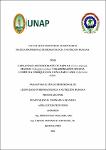| dc.contributor.advisor | Díaz Sangama, Emilio | |
| dc.contributor.advisor | Li Loo Kung, Carlos Antonio | |
| dc.contributor.author | Ushiñahua Ojanama, Eliane Shantal | |
| dc.contributor.author | Reategui Rios, Aura Luz | |
| dc.date.accessioned | 2024-07-01T16:43:38Z | |
| dc.date.available | 2024-07-01T16:43:38Z | |
| dc.date.issued | 2024 | |
| dc.identifier.other | 664.152 U92 2024 | |
| dc.identifier.uri | https://hdl.handle.net/20.500.12737/10236 | |
| dc.description.abstract | This research was carried out in the facilities of the Pilot Canning Plant of the F.I.A., being the raw materials: papaya, mango and camu camu, with the main objective being to find the method of free radical sequestration using the DPPH method (2,2 diphenyl -1- picril-hydrazil) expressed as (μmol TE/100 g. ms): 1.08, 11.23 and 38.67, the % of inhibition was also determined, being the average values; 59.95%. 25.85% and 61.26% the content of total phenols expressed (mg GAE/g.ms) as gallic acid having values of papaya: 0.22, mango, 0.086 camu camu, 12.70, as for the compote enriched with vitamin C, subsequently a standard method was reached, having certain coincidences in the stages of the process. Subsequently, the physicochemical analyses of the three proposed treatments were carried out, plus a blank sample: T0, T1, T2 and T3: moisture: 87.94 g, 87.85 g, 87.73 g, 86.90 g, ash: 0.16 g, 0.17 g, 0.16 g, 0.21 g, proteins: 0.65 g, 0.35 g, 0.30 g, 0.26 g, carbohydrates: 11.15g, 11.41g, 11.80 g, 12.53 g, fat: 0.10 g, 0.22g, 0.01 g, 0.10g, titratable acidity (citric acid): 0.35%, 0.35%, 0.38%, 0.28%, pH(20oC): 6.10, 6.11, 6.07 and 6.23, soluble solids: 9.00, 15.00, 17.50, 18.00, energy (Kcal): 48.10, 49.02, 48.49 and 52.02, dry matter: 12.06 g, 12.15 g, 12.27g, 13.10 g., vitamin C: 0 mg, 130.00 mg, 131.00 mg and 132.00 mg. In relation to microbiological analysis, the three treatments are within the range for human consumption and in the statistical evaluations there is no difference between each treatment. | en_US |
| dc.description.abstract | Esta investigación se ejecutó en las infraestructuras de la Planta Piloto de conservas de la Facultad de Industrias Alimentarias y en parte en Centro de Investigación de Recursos Naturales de la Amazonia, existiendo como objetivo determinar el secuestro de radicales libres usando el método de DPPH (2,2 difenil -1- picril -hidrazil) expresado como (µmol TE/100 g. ms): 1.08, 11.23 y 38.67, también se determinó el porcentaje de inhibición. Existiendo los valores promedios; 59.95%. 25.85% y 61.26% el contenido de fenoles totales expresado (mg GAE/g.ms) calculado con ácido gálico, con lecturas de 517 nm, asumiendo promedios de lectura y cálculos de la pulpa de papaya: 0.22, pulpa de mango, 0.086 de pulpa de camu camu, 12.70, en cuanto a la compota enriquecida con vitamina C, las materias primas fueron pulpa de papaya, pulpa de mango y pulpa camu camu, subsiguientemente se llegó a un método estándar que se dividió en tres materias primas teniendo ciertas coincidencias en las fases del proceso. Posteriormente se ejecutaron los análisis fisicoquímicos de los tres tratamientos propuestos, más una muestra en blanco: T0, T1, T2 y T3: humedad: 87.94g, 87.85 g, 87.73 g, 86.90 g, cenizas: 0.16 g, 0.17 g, 0.16 g, 0.21 g, proteínas:0.65 g, 0.35 g, 0.30 g, 0.26 g, carbohidratos: 11.15 g, 11.41 g, 11.80 g, 12.53 g, grasas: 0.10 g, 0.22 g, 0.01 g, 0.10 g, acidez titulable (C6H8O7): 0.35%, 0.35%, 0.38%, 0.28%, pH(20oC): 6.10, 6.11, 6.07 y 6.23, solidos solubles (oBrix): 9.00, 15.00, 17.50, 18.00, energía (Kcal): 48.10, 49.02, 48.49 y 52.02, materia seca: 12.06 g, 12.15 g, 12.27g, 13.10 g. vitamina C: 0 mg. 130.00 mg, 131.00 mg, 132.00 mg. Con relación al análisis microbiológico los tres tratamientos están dentro del rango para consumo humano y en las evaluaciones estadísticas no hay una diferencia significativa entre cada tratamiento. | es_PE |
| dc.format | application/pdf | es_PE |
| dc.language.iso | spa | es_PE |
| dc.publisher | Universidad Nacional de la Amazonía Peruana | es_PE |
| dc.rights | info:eu-repo/semantics/openAccess | * |
| dc.rights.uri | https://creativecommons.org/licenses/by/4.0/ | * |
| dc.subject | Compotas | es_PE |
| dc.subject | Propiedades antioxidantes | es_PE |
| dc.subject | Papaya | es_PE |
| dc.subject | Carica papaya | es_PE |
| dc.subject | Mango | es_PE |
| dc.subject | Mangifera indica | es_PE |
| dc.subject | Camu camu | es_PE |
| dc.subject | Myrciaria dubia | es_PE |
| dc.title | Capacidad antioxidante de papaya (Carica papaya), mango (Mangifera indica) y elaboración de una compota enriquecida con camu camu (Myrciaria dubia) | es_PE |
| dc.type | info:eu-repo/semantics/bachelorThesis | es_PE |
| thesis.degree.discipline | Bromatología y Nutrición Humana | es_PE |
| thesis.degree.grantor | Universidad Nacional de la Amazonía Peruana. Facultad de Industrias Alimentarias | es_PE |
| thesis.degree.name | Licenciado(a) en Bromatología y Nutrición Humana | es_PE |
| dc.subject.ocde | https://purl.org/pe-repo/ocde/ford#2.11.01 | es_PE |
| renati.author.dni | 71100348 | |
| renati.author.dni | 72966355 | |
| renati.advisor.orcid | https://orcid.org/0000-0002-5424-0937 | |
| renati.advisor.orcid | https://orcid.org/0000-0002-8246-5172 | |
| renati.advisor.dni | 05222152 | |
| renati.advisor.dni | 05414897 | |
| renati.type | https://purl.org/pe-repo/renati/type#tesis | es_PE |
| renati.discipline | 918016 | es_PE |
| renati.level | https://purl.org/pe-repo/renati/level#tituloProfesional | es_PE |
| renati.juror | Cardeña Peña, Genaro Rafael | |
| renati.juror | Alva Angulo, Miriam Ruth | |
| renati.juror | Ríos Cachique, Alfonso Mihuel | |
| dc.publisher.country | PE | es_PE |





